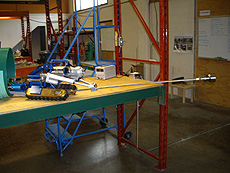Robot vs. grout
 |
An Accelerator Division team led by Michael Geelhoed, Ryan Schultz and their robot, IGoRR, pictured, blasted away at a mound of grout in the Neutrino-Muon beamline with a high-pressure water jet. They successfully eliminated the grout in six weeks. Photo: Ryan Schultz
|
Armed with a 4-foot lance and capable of navigating through a 16-inch-diameter sewer pipe, a tank-like robot named IGoRR recently helped remove 50 gallons of rock-hard grout from inside the Fermilab Neutrino-Muon beamline.
For six weeks this summer, a team led by AD Project Engineer Ryan Schultz remotely directed IGoRR as it blasted and chipped away at the mound of grout with a high-pressure water jet.
"It was a challenging, exhausting and rewarding experience," said Schultz, who conceived the idea for IGoRR and worked with two companies to develop it.
Last year, workers tried to fill concavities in the lower half of the beam pipe with grout to prevent any water that might leak into the pipe from collecting. Unfortunately, the grout hardened in places it wasn't supposed to. It had to be removed, and it proved to be a difficult problem to solve. The grout had 3 times the compressive strength of sidewalk concrete.
"We got the really good stuff," said AD engineering physicist Mike Geelhoed. To complicate matters, it was located 280 feet down the pipe.
After investigating several removal techniques, Schultz decided they needed a robot-controlled water pick with the strength of a jackhammer and the precision of a surgeon.
Canadian company Inuktun supplied the robot, which was mounted with two cameras, and Michigan-based NLB provided the high-pressure pump and nozzle. Schultz and the two companies worked together to develop the robot's articulating arms, designed to hold and steer the water blasting nozzle. Once they put it all together, IGoRR—Inuktun Grout Removal Robot—was born.
The team remotely operated IGoRR, directing it to aim a 20,000-psi jet of water at the grout. It was able to control the water jet with extreme precision. Only six weeks later, the hill of grout was a heap of rubble.
"That's not too shabby for something no one had ever done before and in that amount of time," Geelhoed said. "There wasn't really a textbook on how to do this. It was a great team effort."
And the team included IGoRR.
"Robots are getting more sophisticated and cheaper with time," Schultz said. As the laboratory ramps up beam intensities destined for the Intensity Frontier, radiation levels and exposure will increase. That's where robots like IGoRR can help, he said, performing tasks that limit exposure. "I believe robots have a future at Fermilab."
—Leah Hesla
|